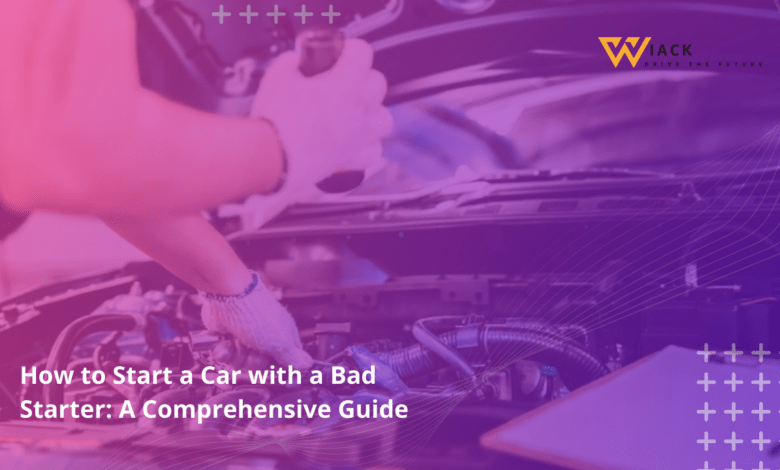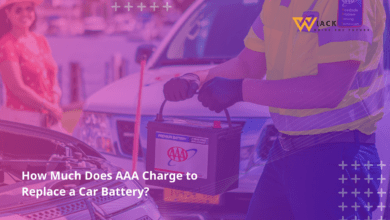How to Start a Car with a Bad Starter: A Comprehensive Guide

Imagine this: You’re running late for an important meeting, rush out to your car, turn the key in the ignition, and… nothing happens. The frustration of a bad starter can leave even the most level-headed driver feeling helpless. But fear not! This comprehensive guide will equip you with the knowledge and techniques to tackle this common automotive issue head-on.
Understanding the Starter
Before we dive into the nitty-gritty of how to start a car with a bad starter, let’s take a moment to understand what a starter is and why it’s so crucial to your vehicle’s operation.
What is a Starter?
A starter is an electric motor that gets your engine running. When you turn the key or push the start button, the starter motor engages, spinning the engine’s flywheel and initiating the combustion process. Think of it as the wake-up call for your car’s engine – without it, your vehicle would remain in a perpetual state of slumber.
The starter system consists of three main components:
- The starter motor
- The solenoid (a type of electromagnetic switch)
- The starter relay
Each of these parts plays a vital role in the starting process, working together like a well-oiled machine to bring your engine to life.
Symptoms of a Bad Starter
Recognizing the signs of a failing starter can save you from unexpected breakdowns and costly repairs. Here are some telltale symptoms to watch out for:
- Clicking sound: If you hear a rapid clicking noise when you turn the key, it could indicate a weak starter or a dead battery.
- Grinding noise: A harsh grinding sound might mean the starter gear isn’t engaging properly with the flywheel.
- Freewheeling: This occurs when the starter motor spins without turning the engine over.
- Intermittent starting: If your car starts sometimes but not others, it could be a sign of a failing starter.
- Smoke: In severe cases, you might see smoke coming from under the hood when trying to start the car.
Remember, these symptoms can sometimes mimic other issues, so it’s essential to diagnose the problem correctly before attempting any repairs.
Common Causes of Starter Failure
Understanding why starters fail can help you prevent future issues and extend the life of your vehicle’s starting system. Here are some common culprits:
- Electrical connections: Loose or corroded battery terminals can prevent the starter from receiving adequate power.
- Worn-out components: Over time, the internal parts of the starter motor can wear down, reducing its effectiveness.
- Extreme temperatures: Both very hot and very cold weather can strain your starter system.
- Oil leaks: If engine oil seeps into the starter, it can cause damage and reduce performance.
- Overworking: Repeatedly trying to start an engine that won’t turn over can overheat and damage the starter.
By being aware of these potential issues, you can take proactive steps to maintain your starter and avoid unexpected failures.
Troubleshooting a Bad Starter
When faced with a bad starter, your first instinct might be to call a tow truck. However, there are several troubleshooting steps you can take that might get your car running without professional help. Let’s explore some of these methods.
Inspecting Connections
Before diving into more complex solutions, start with the basics. Often, the problem isn’t with the starter itself but with the connections that power it. Here’s what to check:
- Battery terminals: Ensure they’re clean and tight. Corrosion can prevent proper electrical flow.
- Ground connection: Check that the ground wire is securely fastened to the engine block or frame.
- Starter connections: Inspect the wires leading to the starter for any signs of damage or looseness.
To clean battery terminals:
- Disconnect the negative terminal first, then the positive.
- Use a mixture of baking soda and water to clean off any corrosion.
- Dry thoroughly and reconnect, starting with the positive terminal.
Remember, safety first! Always wear gloves and eye protection when working with battery connections.
Gently Tapping the Starter
This might sound like an old mechanic’s tale, but gently tapping the starter can sometimes get it working again. Here’s why and how to do it:
- Locate the starter (usually on the driver’s side of the engine, near the bottom).
- Use a solid object like a hammer or wrench handle.
- Give the starter a few moderate taps.
The theory behind this method is that tapping can help unstick the internal components if they’ve become jammed. However, be cautious – too much force can cause damage.
Bypassing the Relay
If the problem lies with the starter relay rather than the starter itself, bypassing it might get your car started. Here’s a simplified process:
- Locate the starter relay in your car’s fuse box.
- Remove the relay.
- Use a jumper wire to connect the battery positive terminal to the starter positive terminal.
Warning: This method should only be used as a temporary solution to get your car to a mechanic. It bypasses important safety features and should not be relied upon long-term.
Alternative Starting Methods
When traditional troubleshooting fails, it’s time to get creative. There are a couple of alternative methods you can try to get your car started despite a bad starter.
Jump-Starting the Vehicle
While typically associated with a dead battery, jump-starting can sometimes work with a bad starter. Here’s how:
- Position another vehicle close to yours, hood-to-hood.
- Turn off both vehicles.
- Connect the red jumper cable to the positive terminal of both batteries.
- Connect the black cable to the negative terminal of the working battery and a ground point on your car (like an unpainted metal surface on the engine block).
- Start the working vehicle and let it run for a few minutes.
- Try to start your car.
If successful, this method can provide enough extra power to overcome a weak starter. However, it won’t solve the underlying issue, so you’ll need to address the starter problem as soon as possible.
Push-Starting the Car (Manual Transmission Only)
For cars with manual transmissions, push-starting (also known as bump-starting) can be an effective way to start a car with a bad starter. Here’s the process:
- Turn the ignition to the “on” position.
- Press the clutch pedal and put the car in second gear.
- Have friends push the car to about 5-10 mph.
- Quickly release the clutch pedal.
- The engine should start. If it doesn’t, try again with a higher speed.
This method works by using the car’s momentum to turn the engine over, bypassing the need for a starter. It’s not suitable for automatic transmissions and can be dangerous if not done carefully, so use this as a last resort.
Addressing a Bad Starter
While the methods we’ve discussed can help you in a pinch, they’re not long-term solutions. Eventually, you’ll need to address the root cause of your starter problems.
When to Call a Mechanic
Sometimes, DIY solutions just won’t cut it. Here are signs it’s time to call in the professionals:
- You’ve tried multiple troubleshooting methods without success.
- You hear unusual noises when trying to start the car.
- There’s visible damage to the starter or surrounding components.
- You’re not comfortable working on your car’s electrical system.
Remember, attempting repairs beyond your skill level can lead to more expensive problems down the road. When in doubt, consult a professional.
Replacing the Starter
If your starter is beyond repair, replacement might be necessary. While this is typically a job for a mechanic, understanding the process can help you make informed decisions:
- Disconnect the battery.
- Locate and remove the starter (this may require lifting the car safely).
- Disconnect all electrical connections to the starter.
- Remove the mounting bolts and take out the old starter.
- Install the new starter, ensuring all connections are secure.
- Reconnect the battery and test the new starter.
The cost of replacement can vary widely depending on your vehicle make and model, but expect to pay anywhere from $200 to $700 for parts and labor.
Maintaining Your Starter
Prevention is always better than cure. Here are some tips to keep your starter in top shape:
- Regular battery checks: A healthy battery puts less strain on your starter.
- Keep connections clean: Regularly clean battery terminals and check for loose connections.
- Avoid short trips: Frequent short trips can prevent your battery from fully charging, leading to starter issues.
- Address oil leaks promptly: Oil can damage your starter if left unchecked.
- Listen for warning signs: Pay attention to any changes in how your car starts and address issues early.
By following these maintenance tips, you can extend the life of your starter and avoid unexpected breakdowns.
FAQs about Starting a Car with a Bad Starter
Let’s address some common questions about dealing with a bad starter.
How to Tell If It’s the Starter or the Battery
Distinguishing between a bad starter and a dead battery can be tricky, as the symptoms are often similar. Here’s a quick guide:
Battery issues:
- Dim or no interior lights
- No sound when turning the key
- Accessories (radio, lights) don’t work
Starter issues:
- Clicking sound when turning the key
- Engine doesn’t turn over despite lights and accessories working
- Intermittent starting problems
If you’re unsure, try jump-starting the car. If it starts and runs fine, the issue is likely with the battery. If it still won’t start, you’re probably dealing with a bad starter.
How Long Can You Drive with a Bad Starter?
Technically, once your car is running, you can drive it with a bad starter. The starter is only needed to get the engine going. However, this doesn’t mean you should ignore the problem. Here’s why:
- Unpredictability: You never know when your car won’t start, potentially leaving you stranded.
- Further damage: Continuing to use a failing starter can cause damage to other components.
- Safety concerns: Being unable to start your car can put you in dangerous situations.
It’s best to address starter issues as soon as possible to avoid these risks.
Can I Start My Car with a Bad Starter?
Yes, it is possible to start a car with a bad starter using some of the methods we’ve discussed:
- Jump-starting
- Push-starting (manual transmission only)
- Tapping the starter
- Bypassing the starter relay
However, these are temporary solutions. They might get you out of a tight spot, but they don’t fix the underlying issue. For long-term reliability, you’ll need to repair or replace the faulty starter.
Final Thoughts
Dealing with a bad starter can be frustrating, but armed with the right knowledge, you can often get your car running and avoid being stranded. Remember these key points:
- Regular maintenance can prevent many starter issues.
- Always prioritize safety when attempting DIY solutions.
- If in doubt, consult a professional mechanic.
- Address starter problems promptly to avoid more serious issues.
By understanding your car’s starting system and knowing how to troubleshoot common problems, you’ll be better prepared to handle unexpected starting issues. Whether you’re faced with a clicking sound, a grinding noise, or complete silence when you turn the key, you now have the tools to diagnose the problem and take appropriate action.
Remember, while it’s great to be able to handle car troubles on your own, there’s no shame in seeking professional help when needed. Your safety and the longevity of your vehicle should always be the top priorities. Happy driving, and may your starts always be smooth!
Get the latest car news, reviews, and prices at Wiack.com. Your one-stop destination for all things automotive.





